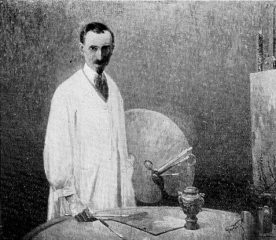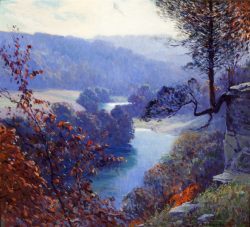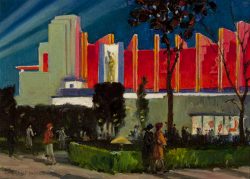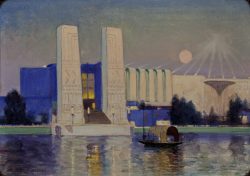Carl Krafft, My Friend Ingerle, undated, unlocated painting reproduced in Art Institute of Chicago, The Catalogue of the Twenty-fifth Annual Exhibition by Artists of Chicago and Vicinity at the Art Institute of Chicago January 25 to February 28 1921 (Chicago: Art Institute of Chicago, 1921).

Rudolph Ingerle 1879–1950
Rudolph Frank Ingerle was born in Vienna, the son of Moravian parents. When he was a boy, the family immigrated to the U.S. to farm in Wisconsin, subsequently settling in Chicago around 1891. Ingerle trained for a career in music before turning to art. He studied at Smith’s Art Academy, in evening classes at the Art Institute of Chicago, and privately with painter Walter Dean Goldbeck. Childhood memories of the mountainous landscape of his ancestral Moravia inspired Ingerle to paint similar settings in the American Midwest, according to later accounts. A member of the Palette and Chisel Club, he was among the first Chicago artists to paint in rural Brown County, Indiana, beginning in 1908. That year, he made his debut with three landscape paintings in the Art Institute’s annual exhibition for Chicago artists (later called the “Chicago and Vicinity” exhibition), where he would show almost every year until the mid-1940s.
In 1913, with Brown County established as a destination for painters, Ingerle searched for new subjects in the Ozark Mountains of Missouri. He and Carl Krafft, with whom he shared a studio, joined with several artists from St. Louis to found the Society of Ozark Painters. Inspired by the region’s distinctive light and topography, Ingerle found his individual artistic style in decorative, rather romantic landscape paintings. Beginning around 1922, he explored the Blue Ridge and the Cumberland Mountains. After first visiting the Great Smoky Mountains of western North Carolina and eastern Tennessee on a 1926 trip with Otto Hake, Ingerle established himself as the premier interpreter of that region. He claimed a modest share in the successful effort to preserve the Smokies, which was designated a national park in 1934.
In 1920 Ingerle won a gold medal from the Bohemian Art Club of Chicago, the first of many prizes that also included two from the Art Institute and a 1928 gold medal from the Chicago Galleries Association. Noted particularly for moonlight scenes, he was a prominent figure in the local art world in the 1920s and 1930s. Ingerle lived in suburban Highland Park, and in 1924 he was a founding member of the North Shore Art League, serving as its first acting president. He was also elected president of the Chicago Society of Artists. A staunch adherent of traditional artistic values, Ingerle was a member of the conservative Association of Chicago Painters and Sculptors, which awarded him a gold medal in 1928 and another prize in 1938. The Art Institute patrons’ group Friends of American Art purchased his Swappin’ Ground in 1928 for the permanent collection of the museum, which gave him a solo exhibition two years later. Ingerle’s celebratory images of the American heartland and the solidly realistic studies of Appalachian character types that he painted in the 1930s embodied anti-modernist ideals. Fittingly, his career was capped with a Logan Prize from the Chicago-based Society for Sanity in Art in 1938. The “painter of the Smokies” died in Highland Park at age sixty-nine.
Wendy Greenhouse, PhD


